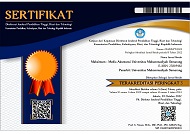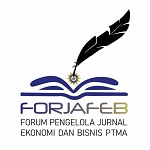Capital Structure Construct and Family Control as Stimulus on Family Business Performance: Evidence From Indonesia
(1) Universitas Pendidikan Indonesia
(2) Universitas Pendidikan Indonesia
(3) Universitas Pendidikan Indonesia
(4) Universitas Pendidikan Indonesia
(*) Corresponding Author
Abstract
The aim of this study is to find out and reproduce how the decision-making process of the capital structure in a family-owned company, and how the family control task serves as a kind of mediation in order to improve the business performance of the company. The target population of this research is the entire family company especially SMEs that is located in Bandung, whose company age is 1 to more than 30 years. Sampling techniques using probability techniques. The total respondents used were 140 respondents who were CEOs or directors and representatives of the family business. The analysis used is using track analysis using Partial Least Square (PLS) The findings of this study show that the process of improving the business performance of a family company is heavily influenced by the accuracy of decision-making in the capital structure and control of the family members themselves.
Keywords
Full Text:
PDFReferences
Abdullah, H., & Tursoy, T. (2021). Capital structure and firm performance: evidence of Germany under IFRS adoption. Review of Managerial Science, 15(2), 379-398.
Abonil, M., Shrivastava, A., & Hyland, L. (2023). Resilience and well‐being among expatriate entrepreneurs: Envisioning life after a global crisis. Global Business and Organizational Excellence.
Arslan-Ayaydin, Ö., Florackis, C., & Ozkan, A. (2014). Financial flexibility, corporate investment and performance: evidence from financial crises. Review of Quantitative Finance and Accounting, 42, 211-250.
Ayuba, H., Bambale, A. J. A., Ibrahim, M. A., & Sulaiman, S. A. (2019). Effects of Financial Performance, Capital Structure and Firm Size on Firms' Value of Insurance Companies in Nigeria. Journal of Finance, Accounting & Management, 10(1).
Babajide, A., Osabuohien, E., Tunji-Olayeni, P., Falola, H., Amodu, L., Olokoyo, F., ... & Ehikioya, B. (2023). Financial literacy, financial capabilities, and sustainable business model practice among small business owners in Nigeria. Journal of Sustainable Finance & Investment, 13(4), 1670-1692
Ball, R., Gerakos, J., Linnainmaa, J. T., & Nikolaev, V. (2020). Earnings, retained earnings, and book-to-market in the cross section of expected returns. Journal of Financial Economics, 135(1), 231-254.
Che Embi, N. A., Jaiyeoba, H. B., & Yussof, S. A. (2019). The effects of students’ entrepreneurial characteristics on their propensity to become entrepreneurs in Malaysia. Education+ training, 61(7/8), 1020-1037.
de Groote, J., Soluk, J., Laue, S. L., Heck, M., & Kammerlander, N. (2023). How can family-owned Mittelstand firms use their unique resources to master the digitalization age? The role of family historical, venture, and collaborative capital. Business Horizons, 66(1), 133-152.
Enriques, L., & Macey, J. R. (2000). Creditors versus capital formation: the case against the European legal capital rules. Cornell L. Rev., 86, 1165.
Faas, L. O. (2023). Strategies Used by Small Traditional Retail Business Owners for Sustainability (Doctoral dissertation, Walden University).
García, C. José, and Begoña Herrero. "Female directors, capital structure, and financial distress." Journal of Business Research 136 (2021): 592-601
Gelpern, A., Horn, S., Morris, S., Parks, B., & Trebesch, C. (2022). How China lends: A rare look into 100 debt contracts with foreign governments. Economic Policy, eiac054.
Kinikar, A. S. (2021). Impact of retained earnings on the short-term solvency and liquidity: A case assessment of excessive profit ploughing through reduced dividend earnings leading to shareholder dissatisfaction. Turkish Online Journal of Qualitative Inquiry, 12(7).
Kliestik, T., Valaskova, K., Lazaroiu, G., Kovacova, M., & Vrbka, J. (2020). Remaining financially healthy and competitive: The role of financial predictors. Journal of Competitiveness, (1).
Kramoliš, J., & Dobeš, K. (2020). Debt as a financial risk factor in SMEs in the Czech Republic. Equilibrium-Quarterly Journal of Economics and Economic Policy.
Lerner, J., & Leamon, A. (2023). Venture capital, private equity, and the financing of entrepreneurship. John Wiley & Sons.
Olusola, B. E., Mengze, H., Chimezie, M. E., & Chinedum, A. P. (2022). The Impact of capital structure on firm performance-evidence from large companies in Hong Kong stock exchange. Open Journal of Business and Management, 10(3), 1332-1361.
Poletti‐Hughes, J., & Martinez Garcia, B. (2022). Leverage in family firms: The moderating role of female directors and board quality. International Journal of Finance & Economics, 27(1), 207-223.
Raimo, N., Vitolla, F., Marrone, A., & Rubino, M. (2020). The role of ownership structure in integrated reporting policies. Business Strategy and the Environment, 29(6), 2238-2250.
Signori, S., & Fassin, Y. (2023). Family members’ salience in family business: An identity-based stakeholder approach. Journal of Business Ethics, 183(1), 191-211.
Stiglitz, J., & Rashid, H. (2020). Averting Catastrophic Debt Crises in Developing Countries. CEPR Policy Insight, 104(1), 1-29.
Tambunan, T. (2019). Recent evidence of the development of micro, small and medium enterprises in Indonesia. Journal of Global Entrepreneurship Research, 9(1), 18.
Tumiwa, J., & Nagy, A. (2021). Micro, small, and medium enterprises in emerging economies and economic transition: a comparative study between Indonesia and
Venturelli, A., Principale, S., Ligorio, L., & Cosma, S. (2021). Walking the talk in family firms. An empirical investigation of CSR communication and practices. Corporate Social Responsibility and Environmental Management, 28(1), 497-510.
Wu, N., Zhao, J., Musah, M., Ma, Z., Zhang, L., Zhou, Y., ... & Li, K. (2023). Do Liquidity and Capital Structure Predict Firms’ Financial Sustainability? A Panel Data Analysis on Quoted Non-Financial Establishments in Ghana. Sustainability, 15(3), 2240.
Article Metrics
Abstract view : 269 timesPDF - 3 times
DOI: https://doi.org/10.26714/mki.14.1.2024.88-101
Refbacks
-----------------------------------------------------------------------------------------------------------------------------------------------------------------------------------
 | MAKSIMUM: Media Akuntansi Universitas Muhammadiyah Semarang |
![]()
Maksimum: Media Akuntansi Universitas Muhammadiyah Semarang is licensed under a Creative Commons Attribution Attribution-NonCommercial-NoDerivatives 4.0 International License.

















